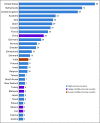Understanding the Value of International Research Networks: An Evaluation of the International Cancer Screening Network of the US National Cancer Institute
- PMID: 31600086
- PMCID: PMC6825249
- DOI: 10.1200/JGO.19.00197
Understanding the Value of International Research Networks: An Evaluation of the International Cancer Screening Network of the US National Cancer Institute
Abstract
Purpose: International research networks have the potential to accelerate scientific progress via knowledge sharing and collaboration. In 2018, the US National Cancer Institute evaluated the International Cancer Screening Network (ICSN), in operation since 1988.
Methods: ICSN hosts a biennial scientific meeting and scientific working groups. A survey was fielded to 665 ICSN participants, and a bibliometric analysis was conducted for ICSN publications.
Results: A total of 243 individuals completed the survey (36.5%). They reported that participating in the ICSN helped advance their knowledge of cancer screening research (75.7%), policy development (56%), and implementation (47.7%). Approximately three-quarters agreed that ICSN facilitated knowledge sharing and networking among researchers and implementers (79.9%) and those working on different continents (74.0%) and cancer sites (73.7%). More than half reported that participating helped them form new collaborations in screening implementation (58.0%) or research (57.6%). Most agreed that ICSN helped to advance screening research and evaluation (75.4%), effective screening practices (71.2%), and screening policies (60.9%). Many reported that participating informed advances in their own research (68.7%) and screening implementation (50.2%) and policies (49.4%) in their settings. Approximately two-thirds agreed that ICSN helped advance career development among current experts (66.6%) and train the next generation (62.2%). Half (51.4%) reported that participating advanced their own careers. The 20 ICSN publications included 75 coauthors. They were cited in 589 publications with more than 2,000 coauthors.
Conclusion: Findings provide evidence of the influence of ICSN on international knowledge dissemination, collaboration, and advances in cancer screening research, implementation, and policies and highlight the potential value of longstanding international research networks.
Conflict of interest statement
The following represents disclosure information provided by authors of this manuscript. All relationships are considered compensated. Relationships are self-held unless noted. I = Immediate Family Member, Inst = My Institution. Relationships may not relate to the subject matter of this manuscript. For more information about ASCO's conflict of interest policy, please refer to
No potential conflicts of interest were reported.
Figures




References
-
- Rebbeck TR, Devesa SS, Chang BL, et al. Global patterns of prostate cancer incidence, aggressiveness, and mortality in men of African descent. Prostate Cancer. 2013;2013:560857. - PubMed
-
- Swerdlow AJ, Harvey CE, Milne RL, et al: The National Cancer Institute Cohort Consortium: An international pooling collaboration of 58 cohorts from 20 countries. Cancer Epidemiol Biomarkers Prev 27:1307-1319, 2018. - PubMed
Publication types
MeSH terms
Grants and funding
LinkOut - more resources
Full Text Sources

